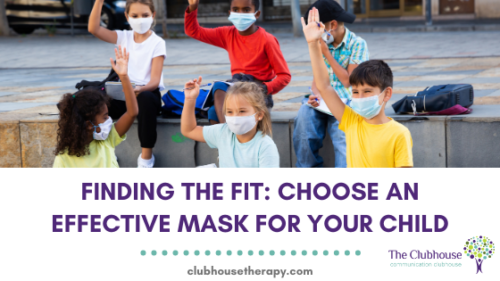Finding the Fit: How to choose a mask that is comfortable and effective for your child
We have had lots of information this year on the importance of wearing masks when out in the community to help prevent the spread of COVID-19. By ensuring our mask has an appropriate fit, we limit the germs that are exchanged when we breathe in and out. Children may not understand the social responsibility of mask wearing, making it especially important to get a well fitting mask. We want them to be as comfortable as possible wearing a mask so they are able to safely participate in their daily routine and activities while keeping the mask on.
Here are some quick ways to tell if your child’s mask fits and simple solutions for adjustments.
Size:
Does their mask completely cover their mouth and nose fully? Ensure that the top of the mask reaches over the tip of their nose and is able to stay in place when talking or moving around. While fitted over their nose, the bottom edge of the mask should be able to also reach under their chin. Some cloth masks are not tall enough to cover both the nose and chin. If your child’s mask appears too short it will need to be replaced by an alternative brand or style. You can look for pleated styles that allow the mask to expand or shrink for the best fit.
Gaps:
Check around the top, side, and bottom edges looking for any gaps. Large gaps present a safety concern by allowing unfiltered air flow between the environment and your child, reducing the effectiveness of wearing a mask. Sometimes, you can improve the gaps caused by loose fitting masks when you tighten the fit (suggestions below). Experiment with styles and brands to find the type of mask that best suits the size and shape of your child’s face.
Fit:
Is the mask fitted too tight or too loose? When masks are too snug across our face, they may rub and tickle our lips causing distraction or discomfort. Tight fitting masks may also bunch and enter our mouth or create tension across our mouth as we try to speak. When worn for prolonged periods, these masks can cause ear tenderness from the pull of the ear loops. Check that when the mask is placed on your child, their ears do not fold, you cannot see the shape of their lips through the mask, and they can open and close their mouths comfortably. If needed, you can tie a shoe lace or piece of string to each ear loop then tie the pieces together at the back of their head to achieve a better fit.
Masks that are too loose can fall down off our nose as we talk or may fall off an ear as we play. They also prevent adequate protection of the nose and mouth reducing safety and efficacy of the mask. You can tighten masks by tying small knots on each ear loop, being careful that each side is even to prevent pulling mask off center. You can also use a string as noted above to tie the mask tighter.
Strategies to help your child tolerate wearing a mask
-
Make it pleasant.
- Pair mask wearing with a preferred and fun activity. We want our kids to become comfortable wearing masks without associating it with negative experiences. By pairing mask wearing with play and our favorite activities, we can focus our attention on something fun while the nerves and our face get used to the feeling of a mask.
-
Model it
- Wear a mask anytime you are asking your child to wear a mask. This helps them understand the expectation and learn that it is normal and safe.
-
Start small
- First, see how much time your child is able to tolerate wearing the mask at home. It is important that we make mask wearing as positive an experience as possible. Then begin to set time frames for mask wearing and gradually increase by small increments (this can be increments of 15 seconds or minutes depending on your child). You may find it useful to use a visual timer on your phone or device to help your child understand the passage of time.
- As they begin to increase their time tolerance of mask wearing, you can pair it with appropriate activities and build it into a routine. This may look like announcing “it’s time to put on your mask and shoes” whenever getting ready to leave home. Ask any other caregivers of your child to help reinforce this by keeping routine and expectations consistent.
Mask options and what to look for:
-
Cloth masks
- Ensure the mask is tall enough to cover their nose and mouth and fits securely under their chin
- Masks with a nose bridge wire help with keeping masks up over their nose
- CDC recommends cloth masks be at least 2 layers of material, other sources recommend 3 layers is ideal.
- When fitted, ensure ears are not being pulled by ear loops and no large gaps appear at any edge.
-
3 ply surgical mask
- Ensure that your child has a child-size surgical mask. If the loops are too long, tie each in a small knot at the end, rather than twisting, as twisting creates larger openings on the sides.
-
Mask with clear panel:
- These masks provide a useful alternative for individuals who may be deaf or hard of hearing, learning to read, or learning language. This is especially useful for speech therapy sessions.
- These masks can collect moisture on the clear panel and extra care may be needed to occasionally clean off or defog.
Written by Bianca Roe, OTD, OTR/L, RDN, LDN
Sources/Websites:
https://www.cdc.gov/coronavirus/2019-ncov/prevent-getting-sick/cloth-face-cover-guidance.html

